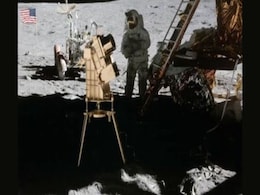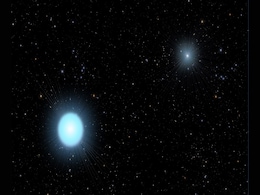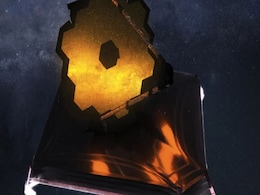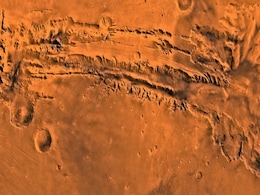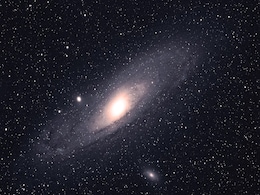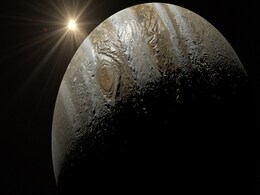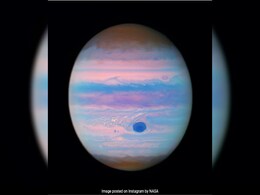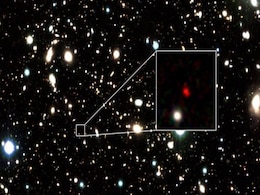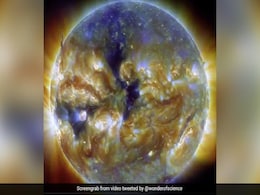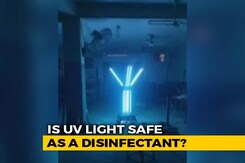Ultraviolet Light
- All
- News
- Videos
-

NASA Prepares 2025 Carruthers Mission to Explore Earth’s Hidden Hydrogen Halo
- Friday September 26, 2025
- Written by Gadgets 360 Staff
NASA’s Carruthers Geocorona Observatory, launching in 2025, will capture ultraviolet light from hydrogen atoms to map Earth’s faint geocorona. Operating a million miles sunward, it will study how solar activity drives atmospheric loss, improves satellite protection, and reveals clues to planetary habitability, providing critical insight for fut...
-
 www.gadgets360.com
www.gadgets360.com
-

NASA Hubble Space Telescope Uncovers One of the Youngest Known Blue Straggler–White Dwarf Systems
- Thursday September 11, 2025
- Written by Gadgets 360 Staff
Italian astronomers using the Hubble Space Telescope have discovered a white dwarf orbiting a blue straggler star in the globular cluster 47 Tucanae, located 15,300 light-years away. The rare system, among the youngest detected, sheds light on stellar mass transfer and offers vital clues to the evolution of binary stars in dense clusters.
-
 www.gadgets360.com
www.gadgets360.com
-

James Webb Telescope Spots Planet Formation in Harshest Known Galactic Environments
- Sunday June 22, 2025
- Written by Gadgets 360 Staff
The James Webb Space Telescope has revealed that planets can form in extreme radiation zones. A protoplanetary disk called XUE 1, exposed to intense ultraviolet light, still shows signs of water and potential for rocky planet formation. The findings challenge old assumptions and broaden the possible regions where Earth-like planets may emerge.
-
 www.gadgets360.com
www.gadgets360.com
-

Is Mars Really Red? A Physicist Explains the Science Behind Its Colour and More
- Saturday June 21, 2025
- Written by Gadgets 360 Staff
A physicist explains the science behind Mars’s red appearance, linking its hue to iron oxide or rust. While known as the Red Planet, rover images and telescope data show varied colors, from tan to white ice caps. Observations in ultraviolet and infrared light reveal deeper insights into Mars’s atmosphere, surface, and seasonal changes, enrichin...
-
 www.gadgets360.com
www.gadgets360.com
-

ISRO’s AstroSat Observes First-Ever Nuclear Explosion in Andromeda Galaxy
- Tuesday December 10, 2024
- Written by Gadgets 360 Staff
Using the Ultraviolet Imaging Telescope (UVIT) aboard ISRO’s AstroSat, scientists have identified far-ultraviolet emissions from 42 novae in the Andromeda Galaxy. This marks the first detection of such emissions during their outbursts, offering new insights into the processes of stellar explosions. Four of these novae were observed in real-time a...
-
 www.gadgets360.com
www.gadgets360.com
-

Here's How Nuclear Clocks Could Redefine Time and Reshape Modern Technology
- Monday December 2, 2024
- Written by Gadgets 360 Staff
Timekeeping is entering a new era with nuclear clocks, capable of achieving accuracy to the 19th decimal place. Current atomic clocks rely on caesium-133, but innovations with thorium-229’s nuclear transitions, excited by ultraviolet light, promise unprecedented precision. Scientists aim to redefine the second using elements like strontium by 203...
-
 www.gadgets360.com
www.gadgets360.com
-

Jupiter’s Earth-Sized Storms Might Be Caused by Magnetic Tornadoes, Study Claims
- Wednesday November 27, 2024
- Written by Gadgets 360 Staff
Magnetic tornadoes twisting down from Jupiter's ionosphere create massive, Earth-sized anticyclonic storms in the planet's atmosphere. These dark ovals, detectable only in ultraviolet light, form dense hazes of aerosols stirred by swirling magnetic vortices. This phenomenon, visible at Jupiter's poles, was unveiled through data from the Hubble Spac...
-
 www.gadgets360.com
www.gadgets360.com
-

Hubble Telescope Finds Unexpectedly Hot Accretion Disk in FU Orionis
- Friday November 22, 2024
- Written by Gadgets 360 Staff
Hubble Space Telescope’s recent observations of FU Orionis have revealed surprising new details about the star’s accretion disk. The study found that the disk’s inner edge reaches temperatures as high as 16,000K, nearly three times hotter than the Sun’s surface. This discovery challenges existing models of stellar accretion, which had predi...
-
 www.gadgets360.com
www.gadgets360.com
-

NASA James Webb Space Telescope Unearths Oversupply of UV Light from Early Stars and Black Holes
- Thursday September 12, 2024
- Written by Gadgets 360 Staff
NASA’s James Webb Space Telescope (JWST) has revealed surprising new details about the universe's reionization process. The telescope has found an unexpected oversupply of ultraviolet (UV) light emitted by early stars and giant black holes, contradicting previous theories. This discovery suggests a more complex reionization process, potentially d...
-
 www.gadgets360.com
www.gadgets360.com
-

NASA Shares Image Of "Fierce" Tarantula Nebula Taken By Hubble Telescope
- Thursday April 4, 2024
- Science | Edited by Anoushka Sharma
The Hubble telescope obtained data in ultraviolet light, which can only be viewed from space, as part of a comprehensive survey.
-
 www.ndtv.com
www.ndtv.com
-

NASA's Hubble Shares Mesmerising Image Of Jupiter In Ultraviolet View
- Monday November 6, 2023
- Science | Edited by Anjali Thakur
NASA said that the storm to the naked eye appears deeper in the UV image as high-altitude haze particles absorb light at these wavelengths.
-
 www.ndtv.com
www.ndtv.com
-

Ultraviolet Nail Polish Dryers At Salons Pose Risk Of Cancer, Claims Study
- Friday January 20, 2023
- Feature | Edited by Anoushka Sharma
The study suggests that the light emitted by a ultraviolet nail polish dryers may increase the risk for developing skin cancer.
-
 www.ndtv.com
www.ndtv.com
-

Astronomers May Have Discovered Universe’s Most Distant Galaxy, Located 13.5 Billion Light-Years Away
- Saturday April 9, 2022
- Edited by Gadgets 360 Newsdesk
Researchers have discovered what they believe to be the farthest astronomical object yet discovered: HD1, a galaxy candidate estimated to be 13.5 billion light-years away. That's an incredible 100 million light-years away from the current farthest galaxy, GN-z11.
-
 www.gadgets360.com
www.gadgets360.com
-

Watch: Mesmerising Timelapse Of The Sun In Ultraviolet Light, Captured Over The Course Of A Month
- Thursday March 31, 2022
- World News | Edited by NDTV Newsdesk
In a video shared on Twitter, we can see the timelapse in “ultraviolet light, captured by the SDO spacecraft over the course of a month”
-
 www.ndtv.com
www.ndtv.com
-

Lower Exposure To UVB Light May Increase Colorectal Cancer Risk, Study Suggests
- Monday July 5, 2021
- ANI
The study describes that inadequate exposure to Ultraviolet B (UVB) light from the sun may be associated with an increased risk of colorectal cancer, particularly in older age groups.
-
 doctor.ndtv.com
doctor.ndtv.com
-

NASA Prepares 2025 Carruthers Mission to Explore Earth’s Hidden Hydrogen Halo
- Friday September 26, 2025
- Written by Gadgets 360 Staff
NASA’s Carruthers Geocorona Observatory, launching in 2025, will capture ultraviolet light from hydrogen atoms to map Earth’s faint geocorona. Operating a million miles sunward, it will study how solar activity drives atmospheric loss, improves satellite protection, and reveals clues to planetary habitability, providing critical insight for fut...
-
 www.gadgets360.com
www.gadgets360.com
-

NASA Hubble Space Telescope Uncovers One of the Youngest Known Blue Straggler–White Dwarf Systems
- Thursday September 11, 2025
- Written by Gadgets 360 Staff
Italian astronomers using the Hubble Space Telescope have discovered a white dwarf orbiting a blue straggler star in the globular cluster 47 Tucanae, located 15,300 light-years away. The rare system, among the youngest detected, sheds light on stellar mass transfer and offers vital clues to the evolution of binary stars in dense clusters.
-
 www.gadgets360.com
www.gadgets360.com
-

James Webb Telescope Spots Planet Formation in Harshest Known Galactic Environments
- Sunday June 22, 2025
- Written by Gadgets 360 Staff
The James Webb Space Telescope has revealed that planets can form in extreme radiation zones. A protoplanetary disk called XUE 1, exposed to intense ultraviolet light, still shows signs of water and potential for rocky planet formation. The findings challenge old assumptions and broaden the possible regions where Earth-like planets may emerge.
-
 www.gadgets360.com
www.gadgets360.com
-

Is Mars Really Red? A Physicist Explains the Science Behind Its Colour and More
- Saturday June 21, 2025
- Written by Gadgets 360 Staff
A physicist explains the science behind Mars’s red appearance, linking its hue to iron oxide or rust. While known as the Red Planet, rover images and telescope data show varied colors, from tan to white ice caps. Observations in ultraviolet and infrared light reveal deeper insights into Mars’s atmosphere, surface, and seasonal changes, enrichin...
-
 www.gadgets360.com
www.gadgets360.com
-

ISRO’s AstroSat Observes First-Ever Nuclear Explosion in Andromeda Galaxy
- Tuesday December 10, 2024
- Written by Gadgets 360 Staff
Using the Ultraviolet Imaging Telescope (UVIT) aboard ISRO’s AstroSat, scientists have identified far-ultraviolet emissions from 42 novae in the Andromeda Galaxy. This marks the first detection of such emissions during their outbursts, offering new insights into the processes of stellar explosions. Four of these novae were observed in real-time a...
-
 www.gadgets360.com
www.gadgets360.com
-

Here's How Nuclear Clocks Could Redefine Time and Reshape Modern Technology
- Monday December 2, 2024
- Written by Gadgets 360 Staff
Timekeeping is entering a new era with nuclear clocks, capable of achieving accuracy to the 19th decimal place. Current atomic clocks rely on caesium-133, but innovations with thorium-229’s nuclear transitions, excited by ultraviolet light, promise unprecedented precision. Scientists aim to redefine the second using elements like strontium by 203...
-
 www.gadgets360.com
www.gadgets360.com
-

Jupiter’s Earth-Sized Storms Might Be Caused by Magnetic Tornadoes, Study Claims
- Wednesday November 27, 2024
- Written by Gadgets 360 Staff
Magnetic tornadoes twisting down from Jupiter's ionosphere create massive, Earth-sized anticyclonic storms in the planet's atmosphere. These dark ovals, detectable only in ultraviolet light, form dense hazes of aerosols stirred by swirling magnetic vortices. This phenomenon, visible at Jupiter's poles, was unveiled through data from the Hubble Spac...
-
 www.gadgets360.com
www.gadgets360.com
-

Hubble Telescope Finds Unexpectedly Hot Accretion Disk in FU Orionis
- Friday November 22, 2024
- Written by Gadgets 360 Staff
Hubble Space Telescope’s recent observations of FU Orionis have revealed surprising new details about the star’s accretion disk. The study found that the disk’s inner edge reaches temperatures as high as 16,000K, nearly three times hotter than the Sun’s surface. This discovery challenges existing models of stellar accretion, which had predi...
-
 www.gadgets360.com
www.gadgets360.com
-

NASA James Webb Space Telescope Unearths Oversupply of UV Light from Early Stars and Black Holes
- Thursday September 12, 2024
- Written by Gadgets 360 Staff
NASA’s James Webb Space Telescope (JWST) has revealed surprising new details about the universe's reionization process. The telescope has found an unexpected oversupply of ultraviolet (UV) light emitted by early stars and giant black holes, contradicting previous theories. This discovery suggests a more complex reionization process, potentially d...
-
 www.gadgets360.com
www.gadgets360.com
-

NASA Shares Image Of "Fierce" Tarantula Nebula Taken By Hubble Telescope
- Thursday April 4, 2024
- Science | Edited by Anoushka Sharma
The Hubble telescope obtained data in ultraviolet light, which can only be viewed from space, as part of a comprehensive survey.
-
 www.ndtv.com
www.ndtv.com
-

NASA's Hubble Shares Mesmerising Image Of Jupiter In Ultraviolet View
- Monday November 6, 2023
- Science | Edited by Anjali Thakur
NASA said that the storm to the naked eye appears deeper in the UV image as high-altitude haze particles absorb light at these wavelengths.
-
 www.ndtv.com
www.ndtv.com
-

Ultraviolet Nail Polish Dryers At Salons Pose Risk Of Cancer, Claims Study
- Friday January 20, 2023
- Feature | Edited by Anoushka Sharma
The study suggests that the light emitted by a ultraviolet nail polish dryers may increase the risk for developing skin cancer.
-
 www.ndtv.com
www.ndtv.com
-

Astronomers May Have Discovered Universe’s Most Distant Galaxy, Located 13.5 Billion Light-Years Away
- Saturday April 9, 2022
- Edited by Gadgets 360 Newsdesk
Researchers have discovered what they believe to be the farthest astronomical object yet discovered: HD1, a galaxy candidate estimated to be 13.5 billion light-years away. That's an incredible 100 million light-years away from the current farthest galaxy, GN-z11.
-
 www.gadgets360.com
www.gadgets360.com
-

Watch: Mesmerising Timelapse Of The Sun In Ultraviolet Light, Captured Over The Course Of A Month
- Thursday March 31, 2022
- World News | Edited by NDTV Newsdesk
In a video shared on Twitter, we can see the timelapse in “ultraviolet light, captured by the SDO spacecraft over the course of a month”
-
 www.ndtv.com
www.ndtv.com
-

Lower Exposure To UVB Light May Increase Colorectal Cancer Risk, Study Suggests
- Monday July 5, 2021
- ANI
The study describes that inadequate exposure to Ultraviolet B (UVB) light from the sun may be associated with an increased risk of colorectal cancer, particularly in older age groups.
-
 doctor.ndtv.com
doctor.ndtv.com

